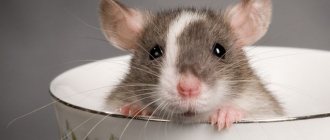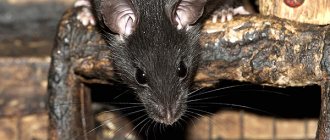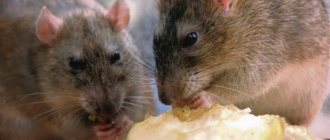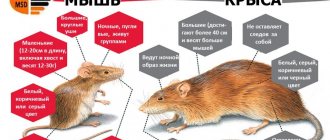Rats: photos of pests.
What harm do rats do to humans?
Rats are one of the hardiest members of the mouse family. They easily adapt to life in unfavorable conditions, and their population can grow several dozen times in just a year. This animal liked living next to people and they cause a lot of trouble for their neighbors.
Rats: numerous neighbors.
What harm do rats pose to human health?
Rodents of this species are capable of spreading a huge number of dangerous diseases.
Back in the 6th century, during the first pandemic of bubonic plague, rats were one of the main carriers of infection.
In the modern world, rats practically do not spread plague, but they become responsible for infecting people and domestic animals with other diseases, such as:
- endemic typhus;
- leptospirosis;
- sodoku;
- salmonellosis;
- rabies;
- visceral leishmaniasis;
- tapeworms;
- Lyme disease;
- Q fever;
- creeping erythema;
- Omsk hemorrhagic fever.
The extent of economic damage caused by rats
This small rodent has a very good appetite and incredibly strong teeth that can even cope with reinforced concrete structures.
An experiment was conducted in the United States, which involved introducing a small rat colony into a grocery warehouse. The rodents stayed there for 60 days and during this time managed to destroy 200 tons of sugar, 14 tons of flour and many packages of cereals, pasta and coffee beans.
In addition to food, rats can damage many other things, such as:
- sewer pipes;
Rats have adapted to being close to humans.
- Electricity of the net;
- building walls;
- furniture;
- household appliances.
The danger of man-made accidents
Another thing that rats are dangerous for humans is that rodents often become the cause of man-made incidents:
- Dam breaks. Rats make holes in dams, as a result of which the body of the dam weakens and water can break through and flood nearby populated areas.
- Electrical network failures. In New York in 1989, a rat shorted out contacts at a distribution station. The animal burned itself and caused a fire, due to which several lines were automatically disconnected. There are similar cases in hospitals, shops and other institutions and they are far from rare.
- Man-made disasters. At one of the airports in China, pilots were unable to start the plane's engine. It turned out that the hose supplying fuel to the engine had been chewed by rats. If something like this had been discovered already in flight, the consequences could have been much worse.
- Food spoilage. In the days of the sailing fleet, it often happened that rats on ships spoiled food, causing people to starve.
- Radiation leaks. The culprit of the 2016 accident in Fukushima is also a rat. The cable in the distribution board was damaged by a rodent. Because of this, a fire broke out and the cooling system stopped working. If it were not for the intervention of the station employees, the consequences could have been even worse.
These are not all cases where rats caused significant harm and became a problem not for one person, but, one might say, for humanity.
How to get rid of rats
Rats are very fertile and thanks to this they are able to quickly capture new territories. At the same time, rodents have a sharp mind and can develop immunity to some poisons. Getting rid of them is not easy, but it is quite possible.
What products do you use against rats?
FolkChemistry and poisons
Chemicals
The best effect in the fight against rodents can be achieved using rat poison. The range of poison-containing drugs for these purposes is quite wide.
Among them there are substances that have an immediate effect and drugs that must accumulate in the body to achieve the desired result.
The first group of drugs causes problems with blood clotting, bleeding and instant death in the animal. The second group leads to kidney or liver failure, which eventually also leads to the death of the rodent.
Rats in the sewer: problems of modern cities.
Mechanical methods of rodent control
Mechanical methods include all kinds of traps and ultrasonic repellers. Among the traps, it is worth highlighting traps, rat traps and live traps.
Traps and rat traps are most often classified as killing devices. They are quite effective and easy to use.
Live traps are more expensive devices and after a rodent is caught, the question arises of how to safely remove it from the trap and what to do with it next.
The operating principle of ultrasonic repellers is based on the emission of high-frequency sound, which irritates the ears of rodents and forces them to move as far as possible from its source.
Folk recipes
There are a lot of traditional methods of controlling rodents. The most effective among them are:
- Spilling of ash . Animals cannot tolerate ash, as it causes irritation on their skin and discomfort when it gets into their stomach.
- Repellents . Rats don't like strong smells. Rolling cotton balls and dipping them in strong-smelling essential oil can help repel rats. The smells that irritate rodents the most are peppermint and eucalyptus.
- A mixture of flour and gypsum. These two components, mixed in equal proportions, are placed near sources of water. After the rat tries the bait and drinks it with water, the plaster will harden in the rodent’s stomach.
The proposed articles describe in more detail a guide to how to get rid of rats on the site and in the barn. GRID
Sodoku: How dangerous is this disease?
Sodoku is a typical rat disease. Rodents themselves get sick from it and die from it, and they can infect humans through bites, since the causative agent of the infection is in the saliva and gets into the wound with it when biting the skin.
Symptoms of sodoku in humans: severe pain at the site of the bite, sometimes with suppuration or swelling; A few days after the bite, the temperature rises and muscle pain appears. The victim may also develop temporary mental disorders - impaired coordination of movements, severe agitation.
This rat disease is easily treated; its causative agent is sensitive to penicillin antibiotics, as well as salvarsan and other drugs for syphilis. At the same time, in the absence of treatment, the mortality rate of the disease reaches 10%, and therefore, even at the first suspicious symptoms, it is necessary to consult a doctor as soon as possible.
Prevention measures
Rats in the city.
It is very difficult to fight rats, so it is better to take timely measures to prevent their occurrence. To do this, you should adhere to the following recommendations:
- keep the area around the home in order and remove garbage in a timely manner;
- check the walls and roof of the room for through holes and eliminate them;
- get rid of sources of standing water on the site;
- get a cat or dog, giving preference to those breeds that are prone to hunting rodents.
Leptospirosis, or another rat disease
Today, WHO considers leptospirosis among the most important diseases that humans contract from animals. In particular, in Russia, back in the last century, leptospirosis was the most common disease transmitted from animals to humans. Its main feature is that the pathogens - Leptospira - are excreted from the body of rats in the urine (a fairly rare occurrence), and the likelihood of infection remains until the urine itself dries (Leptospira survives only in conditions of high humidity).
Leptospirosis is also transmitted through feces; it can be contracted from rats and mice (and in some areas mice are the main spreaders of this infection), as well as from various farm animals. In cities, this is a typical rat infection. You cannot become infected with leptospirosis directly from a sick person.
The main symptoms of the disease are fever, rash on the body, jaundice and hemorrhages in the conjunctiva of the eye. Leptospirosis can affect the heart, brain, and kidneys. The basis of treatment is antibiotic therapy (penicillins and macrolides are effective for the disease); in severe cases, plasmapheresis and the administration of specific serum to the patient are prescribed.
According to medical statistics, in approximately half of cases, leptospirosis is so severe that the patient has to be admitted to intensive care.
Go away!
Rodents reproduce very quickly: during its 3-year life, a rat can give birth to up to 6 thousand cubs.
And they are very difficult to get rid of. Take, for example, the example of Magadan. But why?
Unpretentiousness . Rats can live peacefully both in hot boiler rooms and in refrigeration chambers. Rats can easily withstand even high levels of radiation.
Physics . Rodents run fast, can jump, climb and swim, and can even dive.
Feelings . Rats hear very well, and their perfect sense of smell also plays a huge role. For example, when very frightened, a mouse “marks” the territory with a special smell, which causes its relatives to flee away from a dangerous place. This alarm lasts for several hours.
Smartness . Rats have highly developed intelligence and the ability to analyze information.
Penetrating ability . Medium-sized rodents can fit into a hole with a diameter of only 10 mm. A rat can jump over obstacles up to 80 cm high, and a long jump of 1 meter is common. American studies claim that chilling stories about rats entering houses through sewers and spectacularly emerging from the toilet are not legends, but pure truth.
Rat. Photo: Pixabay
Diseases spread by rodents
Diseases transmitted from rats
Scientists are finding out why rats and mice are dangerous in laboratory conditions. During the course of research, it became known that rodents transmit many dangerous diseases:
- plague;
- encephalitis;
- sodoku;
- streptobacillosis;
- rabies;
- typhus;
- fever;
- cryptosporidiosis;
- giardiasis;
- leptospirosis;
- tularemia;
- listeriosis;
- tuberculosis;
- hepatitis;
- salmonellosis;
- toxoplasmosis;
- parasitic diseases, fungal, viral.
Rodent excrement provokes asthma attacks, the development of an allergic reaction, and exacerbation of atopic dermatitis.
Parasitic diseases
Diseases caused by parasites are considered one of the most common in the world. They appear as a result of the activity of protozoa, helminths (worms), as well as lice, ticks and other similar creatures. All of these living organisms can be carried by rats and other rodents.
Methods of infection:
- direct contact with the rat;
- getting rodent feces into drinking water or food.
Asthma attacks
Because of rats, people suffering from this asthma may experience suffocation attacks. They occur as a result of an allergic reaction to rodent fur or waste products.
Allergic reactions
Rats, like many other animals, can cause allergies. In this case, the disease proceeds in a standard way and is accompanied by characteristic symptoms. These include:
- tearfulness;
- sneezing;
- rhinitis;
- rash.
In most cases, the causative agent is rat fur. However, there are cases where the cause of an allergic reaction was urine or dry excrement of a rodent.
Exacerbation of atopic dermatitis
Atopic dermatitis is a chronic skin disease that is caused by a hereditary predisposition. It is characterized by periodic redness of the skin, accompanied by severe itching. Most often, exacerbations of the problem occur when the patient comes into contact with an allergen. Rat droppings or fur act as an irritating factor.
Possibility of attacks on people
Whether a rat can attack a person is a pressing question. Every year, hundreds of cases of rodents attacking people and leaving bites are recorded around the world.
The risk of being bitten increases in areas where the number of rodents exceeds acceptable limits. An increase in population provokes malnutrition and hunger. This is the main reason for the aggressive behavior of rodents. Rats can attack large mammals, birds, and humans in a hopeless situation:
- if a rodent is cornered, you need to protect your life;
- aggressive behavior is associated with an unbearable feeling of hunger;
- the animal has rabies.
Before jumping on a person, the animal takes a characteristic pose. It rises on its hind legs and a grin appears on its muzzle. Attacks with a jump. It can bite on the legs, arms, and grabs small children by the neck. A rat attacks a person with particular cruelty. An extremely dangerous situation when you have to defend yourself from several rodents.
On a note!
A rat is capable of attacking a person if it feels his helplessness, his superiority. It can calmly bite a sleeping person, a sick person bedridden, or a small child. In most cases, the animal tries to avoid a fight with a person and flees.
Rat bites
A rabid rat bites a person with particular aggressiveness. As the disease progresses, the sense of caution disappears, and the animal mindlessly rushes to attack all living beings. Outwardly, it is distinguished from a healthy rat by the presence of saliva that flows from its mouth and redness of the eyes.
Interesting!
A rodent that has entered human territory will not just attack. The animal behaves cautiously, comes out at night, and tries to quickly hide at the sight of people. If a person finds himself in an area where a rat feels like a master, the situation is different. Rodents try to bite prisoners in prison, homeless people, and plumbers.
Control measures
Over many years of fighting against domestic rodents, people have mastered several basic ways to combat them. They turn homes, or at least food storage facilities, into impregnable fortresses. If gray enemies do appear, then spring mousetraps and glue traps, scarers and poisoned baits are used. At the same time, it is much more difficult to catch, scare away or poison rats than mice. Therefore, people have to constantly invent new means - this is the only way to win the next round of the fight against the arrogant, toothy invaders.
Sources
- https://sesrus.ru/chem-opasny-krysy
- https://notklop.ru/krysy/o-krysah/chem-opasny-krysy/
- https://krot911.ru/krysy/o-krysax/chem-krysy-opasny-dlya-cheloveka.html
- https://apest.ru/krysy/vse-o-krysah/chem-opasny-krysy-dlya-cheloveka/
- https://felisov.ru/uncategorized/chem-opasny-krysy.html
- https://GdeKlop.ru/krysy/napadayut-na-lyudej/
- https://klopam-net.ru/krysy-i-myshi/mozhet-li-krysa-napast-na-spyashhego-cheloveka.html
- https://parazitdoma.ru/krysy-i-myshi/ukus-krysy
- https://ProVyzhivanie.ru/pervaya-pomoshh/ukus-krysy
- https://aif.ru/society/nature/1358516
[collapse]
Musophobia
This term refers to ratphobia, or an unconscious and uncontrollable fear of rats and mice. It should not be confused with aversion to rats, which develops more out of habit or the desire to follow generally accepted patterns of behavior. With musophobia, a person begins to panic at the sight of a rat, not being able to explain the reason for his fear and control himself.
It is easy to identify this symptom: it is enough for a person to show a neat decorative rat or mouse. If the patient begins to shake at the sight of her, it means he really has a phobia. If it turns out that only basement rats or only stories about mutant rats scare him, then we are not talking about illness here, and the fear turns out to be far-fetched.
On a note
It is necessary to distinguish musophobia from zemmiphobia. The latter denotes fear of moles, and a person suffering from it does not necessarily have to be afraid of rats.
Musophobia is treated using a rapprochement technique, which in simple terms can be called “knocking out a wedge with a wedge.” Simply put, the patient is shown rats, but first - cute decorative ones, better - baby rats, perhaps in videos, and then from afar and for a short time, and then gradually reduce the distance and increase the duration of contact.
With a competent medical approach, musophobia can be completely eliminated.
Carriers of infections
Danger of rats
What is dangerous about rats and mice and their bites is that rodents are carriers of many infectious diseases, including such deadly ones as tetanus and rabies, as well as:
- leptospirosis - caused by leptospira, affecting internal organs and the nervous system, the mortality rate from it is 16% of the number of patients; the disease is manifested by high fever, pain in the head and calves, and enlarged liver;
- listeriosis – pathogenic bacteria-listeria are transmitted, especially dangerous for pregnant women, causing miscarriage;
- toxoplasmosis – when pregnant women are infected, the fetus is affected;
- yersiniosis - manifests itself as severe intoxication, affecting the gastrointestinal tract, musculoskeletal system and liver, causing severe pain in muscles, joints, head, severe diarrhea and nausea.











